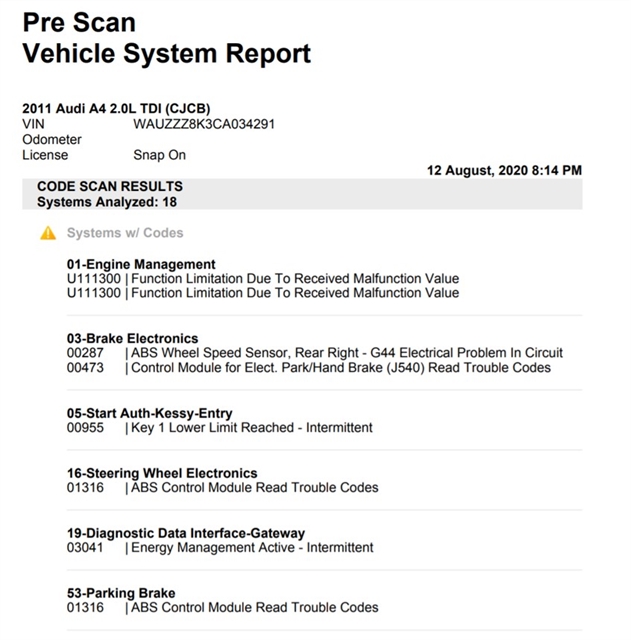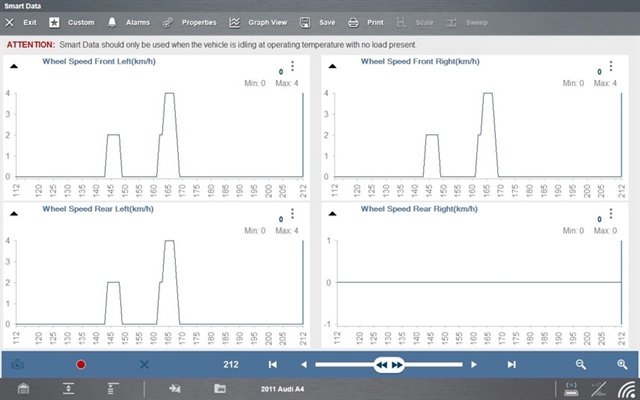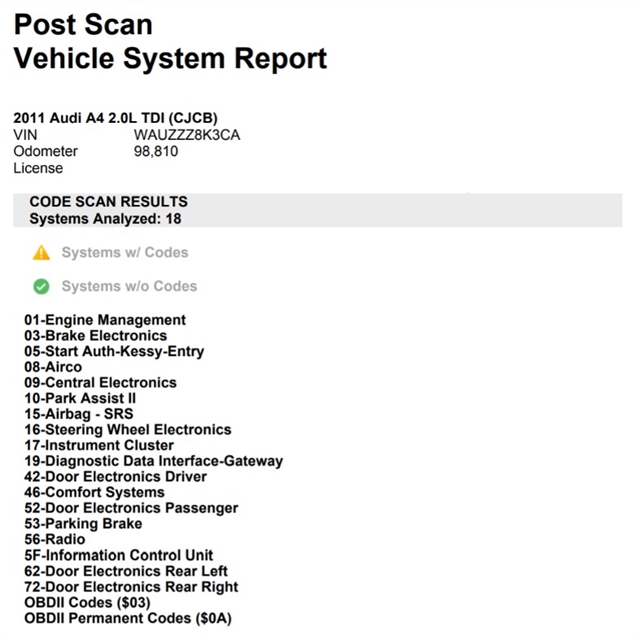A 2011 Audi A4 with a 2.0l diesel CJCB engine had an issue with the ABS light and ESP light staying on intermittently once the vehicle was driven above 5mph.
If the ignition was cycled the lights would turn off but on occasions they would remain on after the initial start-up.
There was also a parking brake malfunction warning light appearing when the issue occurred, but the parking brake operation appeared to be normal.
A pre-scan report with a Snap-on diagnostic platform to establish all trouble codes stored within the vehicle.
The primary code relating to the customer complaint was 00287 – ABS Wheel Speed Sensor, Rear Right – G44 Electrical Problem in Circuit.
Other codes stored appeared to be symptoms of 00287 rather than separate problems.
 |
| The pre-scan vehicle system report for this Audi case study. |
After selecting the trouble code and clicking Diagnose, the Intelligent Diagnostics page overview showed that the rear right ABS sensor was a possible cause.
The green tick next to Technical Service Bulletins indicated that there was no manufacturer technical bulletin relating to the trouble code.
Upon entering the Smart Data section, four data PIDs were listed and these were relevant to the trouble code, meaning there was no need to custom-pick the data from a full list.
Opening up the graphs and moving the vehicle slowly, the rear right wheel speed was not being measured, confirming that the code was correct and the fault was present.
 |
| Intelligent Diagnostics from Snap-on helped confirm the presence of the fault. |
In Intelligent Diagnostics, using the Guided Component Tests, a test for the rear speed sensor was available and carried out.
The results showed normal voltage and signal readings for the rear left but when cycling the ignition, there was a 2.5v bias pulse on both wires for the rear right.
This indicated that the ABS module was carrying out a self-test of the circuit.
Using this self-test bias, it was possible to confirm that the ABS module and wiring were okay and that the issue lay internally in the sensor.
If there was a wiring fault (open or short circuit), this bias would not be present at the sensor multi-plug.
Knowing this, time was saved with not needing to carry out wiring load testing or cross contamination tests.
After replacing the speed sensor, a 12v supply was found on pin 1 and on pin 2 a ground and signal was found, confirming that the new sensor was working as expected.
This is an ‘intelligent’ type sensor which sends out a stationary signal and when the wheel was rotated, a rotation speed was detected.
Looking at the wheel speed live data, all four wheel speeds were identical when the vehicle was moved, proving that there was no issue with the new sensor.
After a road test was carried out, there were no warning lights remaining on the dashboard.
 |
| The post-scan vehicle system report for this case study. |
Carrying out a post-scan report showed there were no trouble codes stored in any module, demonstrating that the previous codes stored were a symptom of the faulty wheel speed sensor.
Date posted: 19 October 2020